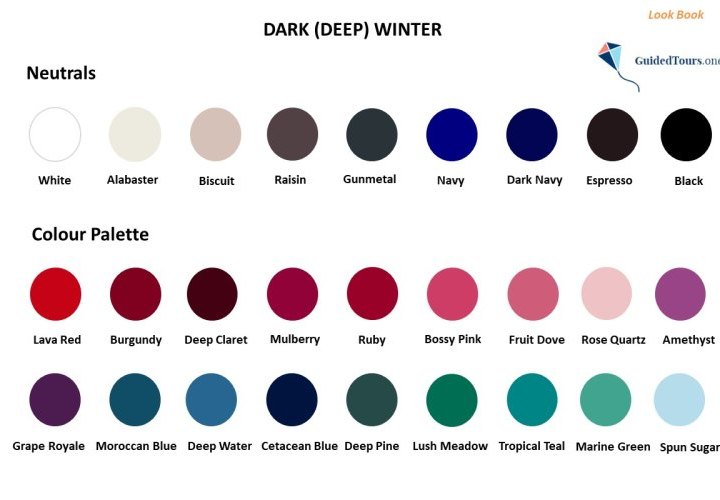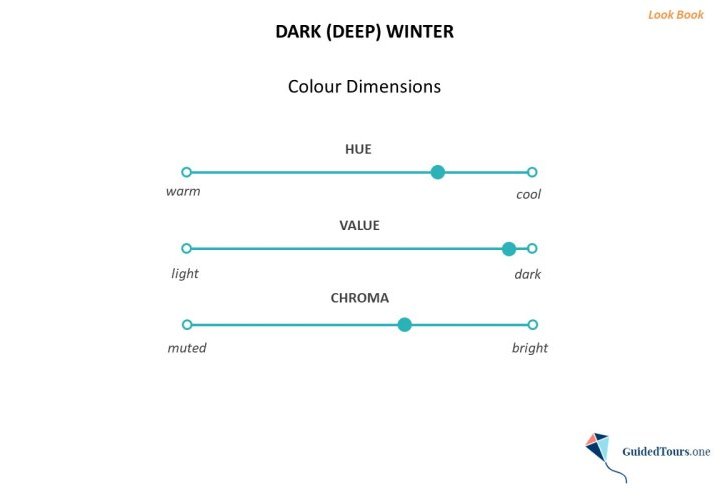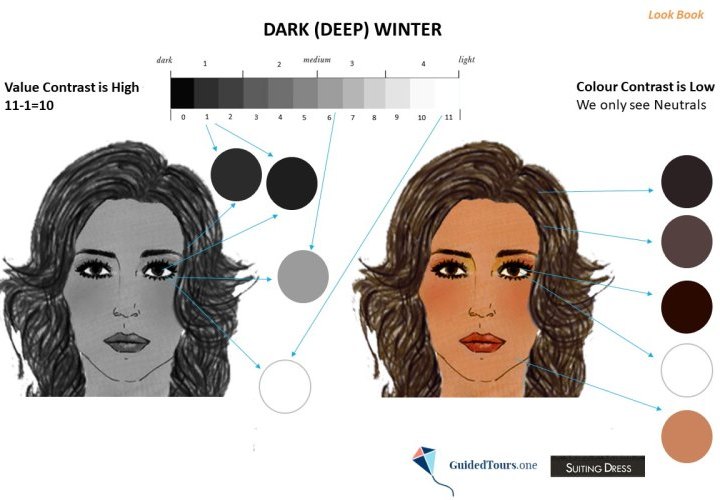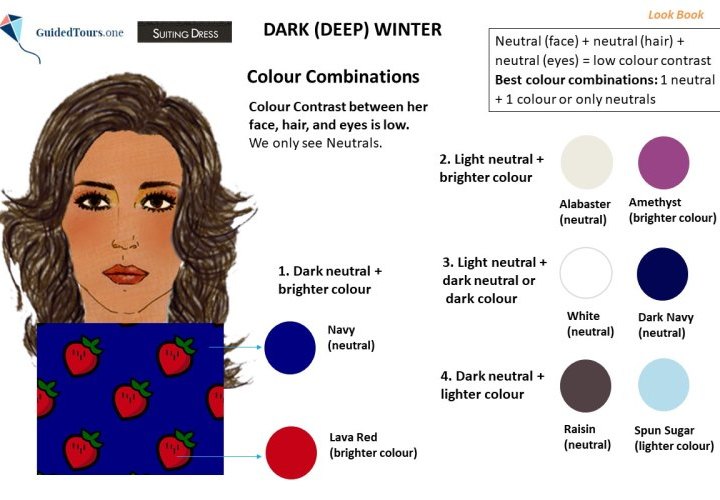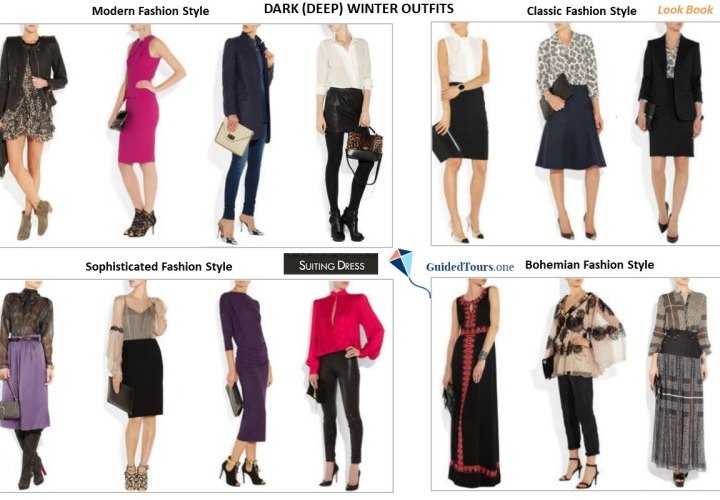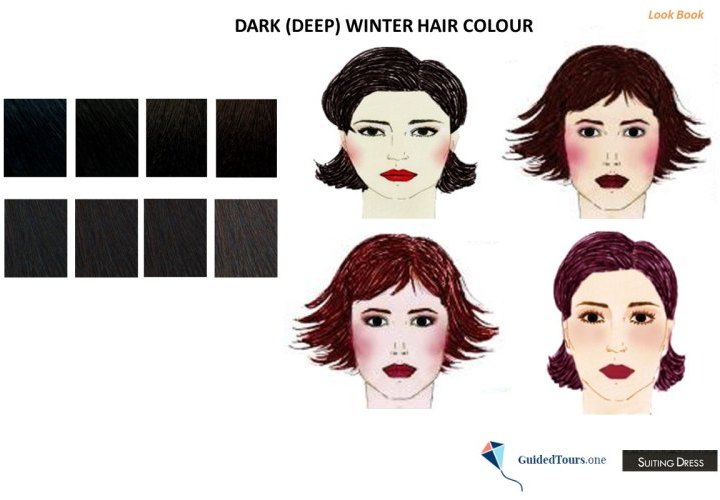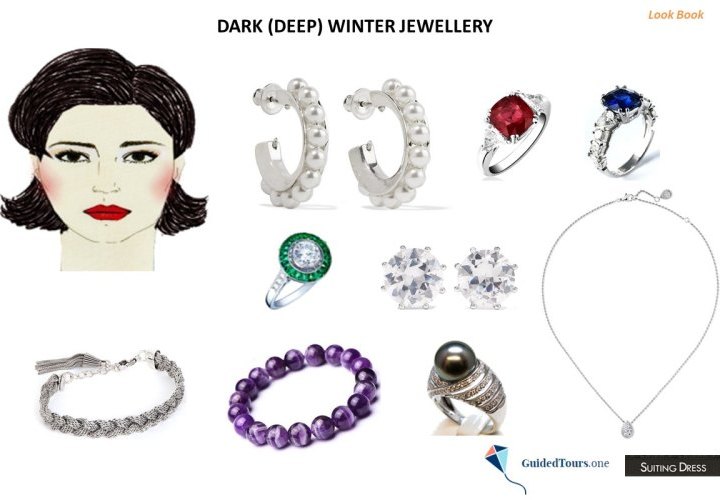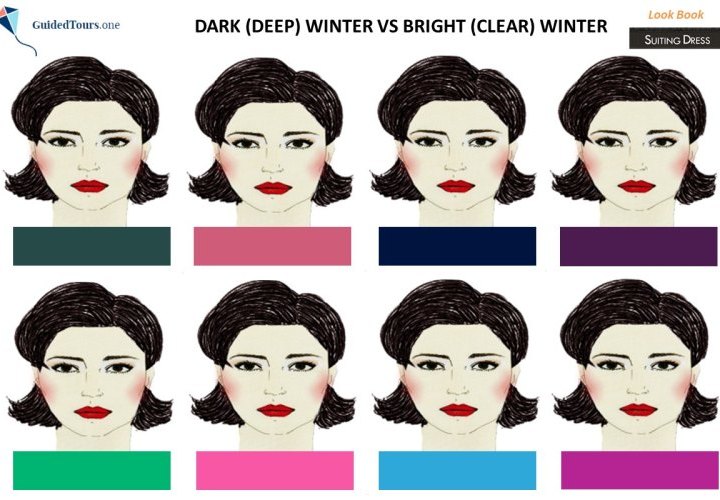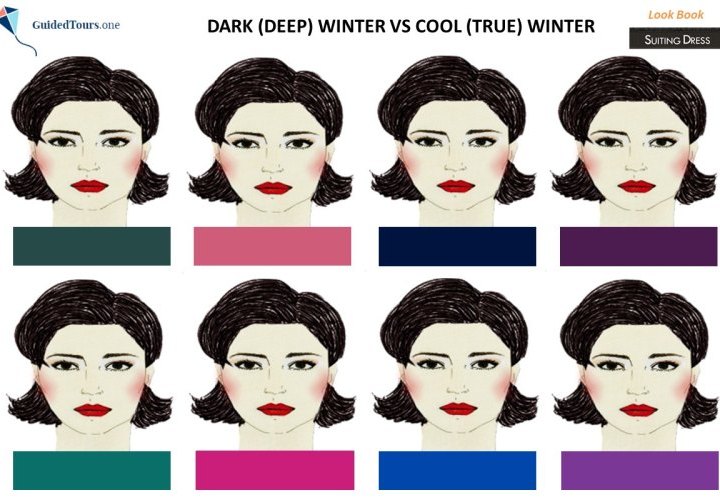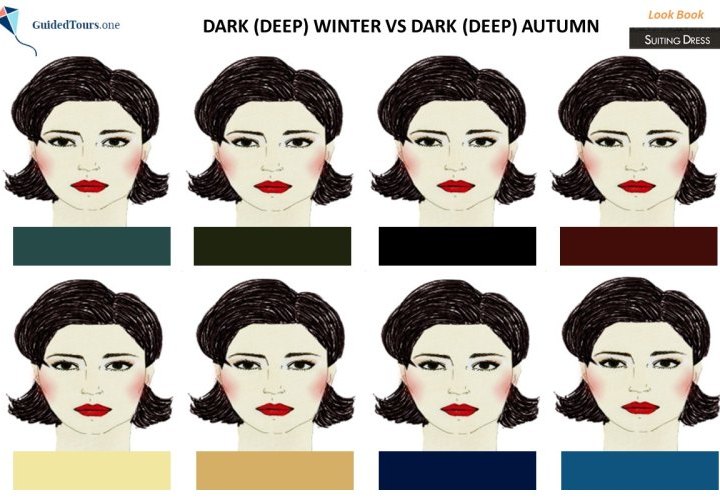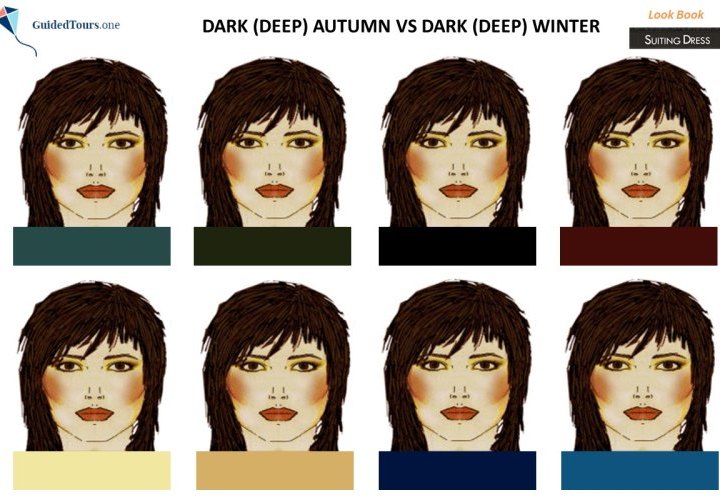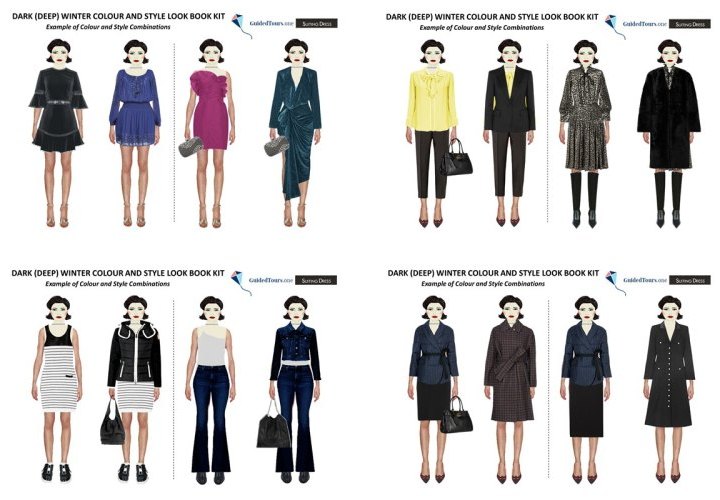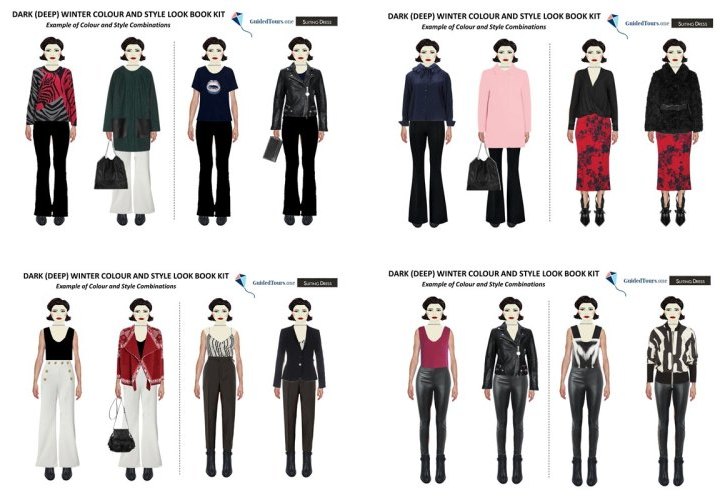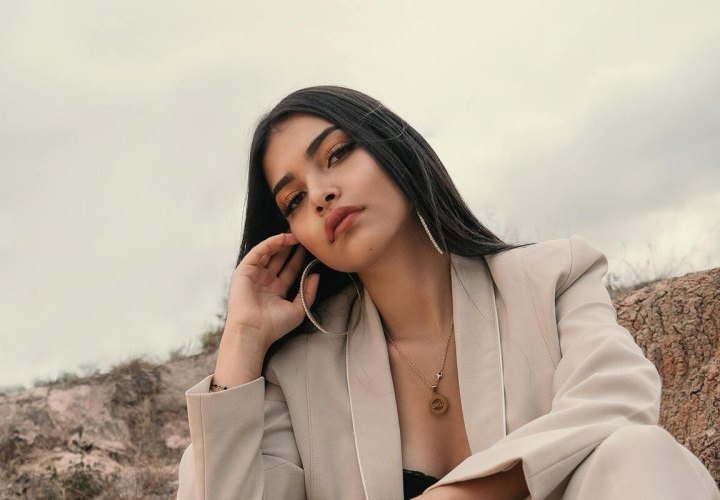Dark (Deep) Winter is the darkest season of the Winter family (Dark Winter, True/Cool Winter and Bright Winter) and it sits between True/Cool Winter and Dark/Deep Autumn on the seasonal flow chart. Unlike Dark Autumn, which has warm leaning neutral undertones, Dark (Deep) Winter has cool leaning neutral undertones. This season type is also different from True Winter, which is completely cool.
If we examine the Colour Dimensions of Dark (Deep) Winter (image 2) we can see that it is first of all Dark, and then it is cool and after that bright.
Hue: Cool/Neutral Cool (the hues of Deep Winter are primarily cool, but as we can see on the image, they are not extremely cool and can also have some neutral shades).
Value: Dark/Deep (Dark/Deep Winter is the darkest season of the Winter family, more
If we examine the Colour Dimensions of Dark (Deep) Winter (image 2) we can see that it is first of all Dark, and then it is cool and after that bright.
Hue: Cool/Neutral Cool (the hues of Deep Winter are primarily cool, but as we can see on the image, they are not extremely cool and can also have some neutral shades).
Value: Dark/Deep (Dark/Deep Winter is the darkest season of the Winter family, more
and this is the main colour aspect of this season type).
Chroma: Medium-bright (Deep Winter has a medium-bright chroma, meaning that it falls towards the middle on the Colour Dimensions chart).
Now, let’s examine the features (hair, skin tone, eyes) of Deep Winter representatives.
Hair: Dark/Deep Winter hair is dark, ranging from medium brown to true black. It is generally either neutral or slightly ashy and doesn’t have any highlights.
Skin tone: Dark/Deep Winter skin has a big range of skin tones, ranging from fair to deep and can be light, medium, tan or dark.
Eye Colours: Dark/Deep Winter eyes are also dark and are generally dark brown and black, but can also be dark olive, dark hazel or even dark blue (rarely).
Colour Palette
Just like Dark/Deep Winter’s primary colour dimensions, Dark/Deep Winter colours are dark, cool/neutral cool, and medium bright to be in line with this season type natural colouring.
While the overall Deep Winter Colour Palette (image 1) is dark, there are many colours that are very light. This mixture in value is needed to achieve a high value contrast, as the contrast between this season type features (you will find more details about this in the next section).
The colours lean towards the cool end of the scale, and they are dark and somewhat bright. The colour palette includes pinks, reds, purples, blues and greens. Deep winter representatives really shine in powerful, deep shades that can overpower other seasons.
At the same time, there are many neutrals in the palette, including black, white, biscuit, raisin, and navy. While most true whites and blacks will work for you as a Dark/Deep Winters, good options are also alabaster and espresso neutrals. As you are medium-bright, wearing grey on its own can make you become washed out, but you can opt for grey neutrals which are not too muted or dusty, including gunmetal, a dark grey with bluish and green tinge.
Deep Winter worst colours are light and warm, because they are opposed to dark and cool, the main colour aspects of this season type.
Chroma: Medium-bright (Deep Winter has a medium-bright chroma, meaning that it falls towards the middle on the Colour Dimensions chart).
Now, let’s examine the features (hair, skin tone, eyes) of Deep Winter representatives.
Hair: Dark/Deep Winter hair is dark, ranging from medium brown to true black. It is generally either neutral or slightly ashy and doesn’t have any highlights.
Skin tone: Dark/Deep Winter skin has a big range of skin tones, ranging from fair to deep and can be light, medium, tan or dark.
Eye Colours: Dark/Deep Winter eyes are also dark and are generally dark brown and black, but can also be dark olive, dark hazel or even dark blue (rarely).
Colour Palette
Just like Dark/Deep Winter’s primary colour dimensions, Dark/Deep Winter colours are dark, cool/neutral cool, and medium bright to be in line with this season type natural colouring.
While the overall Deep Winter Colour Palette (image 1) is dark, there are many colours that are very light. This mixture in value is needed to achieve a high value contrast, as the contrast between this season type features (you will find more details about this in the next section).
The colours lean towards the cool end of the scale, and they are dark and somewhat bright. The colour palette includes pinks, reds, purples, blues and greens. Deep winter representatives really shine in powerful, deep shades that can overpower other seasons.
At the same time, there are many neutrals in the palette, including black, white, biscuit, raisin, and navy. While most true whites and blacks will work for you as a Dark/Deep Winters, good options are also alabaster and espresso neutrals. As you are medium-bright, wearing grey on its own can make you become washed out, but you can opt for grey neutrals which are not too muted or dusty, including gunmetal, a dark grey with bluish and green tinge.
Deep Winter worst colours are light and warm, because they are opposed to dark and cool, the main colour aspects of this season type.
Value Contrast
The value (or depth) shows how light or dark a colour is, while the value contrast is the level of difference in value between two or more colours. The closer together colours are, the lower is the level of contrast between them, and the farther apart colours are, the higher is the level of contrast.
Dark/Deep Winter representatives can have either dark hair, eyes, and skin or dark hair, eyes and very light skin. Regardless of your skin colour, there is always a high value contrast between the features, because if your skin is darker, the whites of the eyes will provide a high contrast against the dark hair and eyes.
On the image on your right, you can see a Dark Winter representative with dark hair, eyes and a darker skin. The whites of her eyes create a high contrast against her dark hair and eyes. more
The value (or depth) shows how light or dark a colour is, while the value contrast is the level of difference in value between two or more colours. The closer together colours are, the lower is the level of contrast between them, and the farther apart colours are, the higher is the level of contrast.
Dark/Deep Winter representatives can have either dark hair, eyes, and skin or dark hair, eyes and very light skin. Regardless of your skin colour, there is always a high value contrast between the features, because if your skin is darker, the whites of the eyes will provide a high contrast against the dark hair and eyes.
On the image on your right, you can see a Dark Winter representative with dark hair, eyes and a darker skin. The whites of her eyes create a high contrast against her dark hair and eyes. more
In order to determine her value contrast level, we converted her photo into greyscale and assigned a value from 0 to 11 to her hair, skin, and eyes (1 to her hair and eyes, 6 to her skin, and 11 to the whites of her eyes). Next, we took the highest number and took away the lowest number (for example 11-1=10). According to our value contrast scale that you can see below, she has a high value contrast.
A) 0 - 2 (low value contrast)
B) 3 - 5 (medium-low value contrast)
C) 6 - 8 (medium-high value contrast)
D) 9 - 11 (high value contrast)
The high value contrast, shows us that she can wear highly contrasted colours with very different values without problems and her clothes should not be more than 10 values apart. In this particular case, it will be better for her to wear dark navy with white, than black with white, which according to our scale are numbered 0 (black) and 11 (white). However, many Deep Winters have the highest value contrast (11) and can wear black and white.
Following this example, you can examine your own features and see if there is a high value contrast between them. Dark/Deep Winters typically have a high value contrast between their features.
Colour Contrast
In terms of colour contrast, Dark/Deep Winters typically have a low colour contrast, as their features are mostly neutral. Dark/Deep Winters with dark olive or dark blue eyes may have some colour in their features, but the colour contrast will still be low, as these colours may be perceived more as neutral colours.
On the image on your right, you can see that the Colour Contrast of the same Dark/Deep Winter representative selected by us is low, as we can only see neutrals in her face: neutral hair, neutral skin and neutral eyes. The best colour combinations will be: 1 neutral + 1 colour or only neutrals.
Following this example, you can examine your own features and see if there is a low colour contrast between them. Dark/Deep Winters typically have a low colour contrast between their features.
A) 0 - 2 (low value contrast)
B) 3 - 5 (medium-low value contrast)
C) 6 - 8 (medium-high value contrast)
D) 9 - 11 (high value contrast)
The high value contrast, shows us that she can wear highly contrasted colours with very different values without problems and her clothes should not be more than 10 values apart. In this particular case, it will be better for her to wear dark navy with white, than black with white, which according to our scale are numbered 0 (black) and 11 (white). However, many Deep Winters have the highest value contrast (11) and can wear black and white.
Following this example, you can examine your own features and see if there is a high value contrast between them. Dark/Deep Winters typically have a high value contrast between their features.
Colour Contrast
In terms of colour contrast, Dark/Deep Winters typically have a low colour contrast, as their features are mostly neutral. Dark/Deep Winters with dark olive or dark blue eyes may have some colour in their features, but the colour contrast will still be low, as these colours may be perceived more as neutral colours.
On the image on your right, you can see that the Colour Contrast of the same Dark/Deep Winter representative selected by us is low, as we can only see neutrals in her face: neutral hair, neutral skin and neutral eyes. The best colour combinations will be: 1 neutral + 1 colour or only neutrals.
Following this example, you can examine your own features and see if there is a low colour contrast between them. Dark/Deep Winters typically have a low colour contrast between their features.
As seen in the previous section, the value contrast between Dark/Deep Winter features is high, while the colour contrast is low.
Therefore, Dark Winter representatives can combine colours with very different values from black to white (taking into consideration the value contrast number), but the best combinations are those that repeat the value contrast level present in the appearance.
In terms of colour, the best colour combinations for Dark/Deep Winter, which has neutral hair, skin and eyes will be only neutrals or 1 neutral and 1 colour. This colour combination system was created by us and supposes 4 colour combination possibilities based on each season features colour.
The best colour combinations for Dark/Deep Winter representatives (image 1), more
Therefore, Dark Winter representatives can combine colours with very different values from black to white (taking into consideration the value contrast number), but the best combinations are those that repeat the value contrast level present in the appearance.
In terms of colour, the best colour combinations for Dark/Deep Winter, which has neutral hair, skin and eyes will be only neutrals or 1 neutral and 1 colour. This colour combination system was created by us and supposes 4 colour combination possibilities based on each season features colour.
The best colour combinations for Dark/Deep Winter representatives (image 1), more
who have a low colour contrast, are the following:
1. A dark neutral + a brighter colour (1 neutral + 1 colour)
2. A light neutral + a brighter colour (1 neutral + 1 colour)
3. A light neutral + a dark neutral or dark colour (only neutrals or 1 neutral + 1 colour)
4. A dark neutral + a lighter colour (1 neutral + 1 colour)
The colour combination formed by a dark neutral and a dark colour was not included for our selected Dark Winter representative, because there is no contrast between the values and an all dark look will be too dark for her. However, if you have light skin and dark hair and eyes, an overall dark outfit will work for you, but will not be your best. If you choose an all dark outfit, try balancing that dark effect with a small addition of colour from your palette (a handbag or other accessory can help).
In terms of prints, the best patterns are those that only contain Dark/Deep Winter colours, but if you can’t find a print that is completely within your palette, you can opt for a print that also has small colour spots from a disharmonious palette. For example, on the image on your right, you can see a print that contains lava red strawberries with clear black edges and green calices on a navy background. While the lava red, navy and black are part of Dark/Deep Winter colour palette, the warm green is not. It belongs to Spring season, but as the warm green calices are small and bright, the overall print looks harmonious on the Dark Winter representative chosen by us.
The best prints for Dark Winter are bold and highly contrasted, and contain delineated colours (like in our example), not soft-edged or blended colours. The patterns with geometric shapes with repeating designs and sharper edges, stylized flowers, or abstract prints are great.
Dark/Deep winters have a sophisticated palette with many options for classic and sophisticated style. On the image on your right (image 2), you can see some Dark/Deep Winter Colour Palette Outfits belonging to modern, classic, sophisticated and bohemian fashion style. You can experiment with the colours in your palette to create a high value contrast, and find the style that works better for you (or combine styles). While black and white combination can work, there are many more colours such as grape royale, burgundy or tropical teal that look absolutely amazing on Dark/Deep Winters.
1. A dark neutral + a brighter colour (1 neutral + 1 colour)
2. A light neutral + a brighter colour (1 neutral + 1 colour)
3. A light neutral + a dark neutral or dark colour (only neutrals or 1 neutral + 1 colour)
4. A dark neutral + a lighter colour (1 neutral + 1 colour)
The colour combination formed by a dark neutral and a dark colour was not included for our selected Dark Winter representative, because there is no contrast between the values and an all dark look will be too dark for her. However, if you have light skin and dark hair and eyes, an overall dark outfit will work for you, but will not be your best. If you choose an all dark outfit, try balancing that dark effect with a small addition of colour from your palette (a handbag or other accessory can help).
In terms of prints, the best patterns are those that only contain Dark/Deep Winter colours, but if you can’t find a print that is completely within your palette, you can opt for a print that also has small colour spots from a disharmonious palette. For example, on the image on your right, you can see a print that contains lava red strawberries with clear black edges and green calices on a navy background. While the lava red, navy and black are part of Dark/Deep Winter colour palette, the warm green is not. It belongs to Spring season, but as the warm green calices are small and bright, the overall print looks harmonious on the Dark Winter representative chosen by us.
The best prints for Dark Winter are bold and highly contrasted, and contain delineated colours (like in our example), not soft-edged or blended colours. The patterns with geometric shapes with repeating designs and sharper edges, stylized flowers, or abstract prints are great.
Dark/Deep winters have a sophisticated palette with many options for classic and sophisticated style. On the image on your right (image 2), you can see some Dark/Deep Winter Colour Palette Outfits belonging to modern, classic, sophisticated and bohemian fashion style. You can experiment with the colours in your palette to create a high value contrast, and find the style that works better for you (or combine styles). While black and white combination can work, there are many more colours such as grape royale, burgundy or tropical teal that look absolutely amazing on Dark/Deep Winters.
Dark/Deep Winter hair is dark, ranging from medium brown to true black and is generally either neutral or slightly ashy and doesn’t have any highlights.
Usually, the best hair colour for Dark/Deep Winters is their natural hair colour, but if you want to change your natural hair colour, you should opt for another Dark/Deep Winter hair colour. Remember that your natural colour aspect is first of all dark and cool, and hair colour should also follow your natural colouring. A lighter hair colour (including blonde) can throw off your contrast level and damage your hair.
Advising and choosing a new hair colour is, above all, respecting your high contrast level and the natural cold base. Great hair colours for you would be cool dark brown, more
Usually, the best hair colour for Dark/Deep Winters is their natural hair colour, but if you want to change your natural hair colour, you should opt for another Dark/Deep Winter hair colour. Remember that your natural colour aspect is first of all dark and cool, and hair colour should also follow your natural colouring. A lighter hair colour (including blonde) can throw off your contrast level and damage your hair.
Advising and choosing a new hair colour is, above all, respecting your high contrast level and the natural cold base. Great hair colours for you would be cool dark brown, more
natural black, cool dark red, or dark plum. On the image on your right, you can see how various Dark Winter representatives look with black, cool dark red and plum hair colours. If you like red colours, and would like to opt for a dark red colour, choose the colour with caution and avoid any warm reds. It is important to stay in the same cool category so as not to create disharmony with the complexion.
Dark Winter lipstick colours come from the pink, red and purple shades as well as brown neutrals included in the Dark Winter Colour Palette. As Dark Winter’s natural appearance is dark, cool and bright, Dark Winter lipstick is at its best when its similarly dark, cool and intense.
Lipstick is one of the most interesting products for Dark Winters, as they can try very dark and intense colours that would complement the value contrast seen between their features. So, don’t be afraid to go for darker and more intense shades like those that you can see on our Dark Winter representative (lipstick red, burgundy, mulberry, ruby, garnet, deep claret, and dark plum). If you find these lipstick colours too intense, you can try the lighter colours from the Dark Winter Colour Palette such as bossy pink or fruit dove. more
As Dark Winters are cool, they should avoid warm, orange-based lipstick colours, and as they have a very high value contrast, they should avoid nude, skin-coloured lips. Darker lipstick colours will create a beautiful high value contrast between your lips and your whiter skin (the whites of your eyes if you have a darker skin tone), while nude lipstick will look strange on you. If you like neutral lipstick colours, opt for a dark chocolate or expresso colour.
Dark Winters are somewhat bright, so avoid completely matte lipsticks, and opt instead for a slight shine.
Lipstick is one of the most interesting products for Dark Winters, as they can try very dark and intense colours that would complement the value contrast seen between their features. So, don’t be afraid to go for darker and more intense shades like those that you can see on our Dark Winter representative (lipstick red, burgundy, mulberry, ruby, garnet, deep claret, and dark plum). If you find these lipstick colours too intense, you can try the lighter colours from the Dark Winter Colour Palette such as bossy pink or fruit dove. more
As Dark Winters are cool, they should avoid warm, orange-based lipstick colours, and as they have a very high value contrast, they should avoid nude, skin-coloured lips. Darker lipstick colours will create a beautiful high value contrast between your lips and your whiter skin (the whites of your eyes if you have a darker skin tone), while nude lipstick will look strange on you. If you like neutral lipstick colours, opt for a dark chocolate or expresso colour.
Dark Winters are somewhat bright, so avoid completely matte lipsticks, and opt instead for a slight shine.
Dark Winter nail polish colours are taken from the same colour palette that is used for clothing. On our image you can see various Dark Winter colours that you can choose from, but the best options are dark and intense as your features. In order to pick a winning colour, just keep in mind that you are dark, cool and bright.
At the same time, as Dark Winters have a low colour contrast, they can combine 1 colour and 1 neutral or only neutrals on their nails to create impressive designs. The same best colour combinations that are relevant for clothes also apply for nail polish, but you should also keep in mind your value contrast number. The best colour combinations for Dark (Deep) Winter representatives, who have a low colour contrast, are the following:
1. A dark neutral + a brighter colour (1 neutral + 1 colour)
2. more
At the same time, as Dark Winters have a low colour contrast, they can combine 1 colour and 1 neutral or only neutrals on their nails to create impressive designs. The same best colour combinations that are relevant for clothes also apply for nail polish, but you should also keep in mind your value contrast number. The best colour combinations for Dark (Deep) Winter representatives, who have a low colour contrast, are the following:
1. A dark neutral + a brighter colour (1 neutral + 1 colour)
2. more
A light neutral + a brighter colour (1 neutral + 1 colour)
3. A light neutral + a dark neutral or dark colour (only neutrals or 1 neutral + 1 colour)
4. A dark neutral + a light colour (1 neutral + 1 colour)
When you create nail designs, keep your nail polish colours to 1 colour and 1 neutral, because too many different colours will interfere with your low colour contrast and could leave you looking like a clown.
3. A light neutral + a dark neutral or dark colour (only neutrals or 1 neutral + 1 colour)
4. A dark neutral + a light colour (1 neutral + 1 colour)
When you create nail designs, keep your nail polish colours to 1 colour and 1 neutral, because too many different colours will interfere with your low colour contrast and could leave you looking like a clown.
Dark/Deep Winters colouring has cooler undertones, and silver flatters their skin more than gold. If you are a Dark/Deep Winter, your best metals will be silver and platinum, either shiny or matte. If you want to wear gold, choose a darker one that is not too yellow.
In terms of stones, diamonds, rubies, amethysts, sapphires and emeralds are ideal for Dark/Deep Winter. White or metallic grey pearls would also look great on Deep Winters, but we suggest you to opt for faux pearls to show that you care about oysters and molluscs. Pearl extraction is not considered ethical, as oysters and other molluscs only produce pearls as a response to a stressful environment. Faux pearls can be just as beautiful as natural pearls, and they are ethical.
On the image on your right, more
In terms of stones, diamonds, rubies, amethysts, sapphires and emeralds are ideal for Dark/Deep Winter. White or metallic grey pearls would also look great on Deep Winters, but we suggest you to opt for faux pearls to show that you care about oysters and molluscs. Pearl extraction is not considered ethical, as oysters and other molluscs only produce pearls as a response to a stressful environment. Faux pearls can be just as beautiful as natural pearls, and they are ethical.
On the image on your right, more
you can see some pieces of Dark/Deep Winter jewellery including earrings, rings, and bracelets. Besides taking into consideration what earrings to wear based on your season type, you should also consider the following: 1) what earrings (shape and size) are best for your face shape; 2) how to combine earrings with your dress style (for example modern, classic, sophisticated, etc.).
If you are not sure whether you are a Dark (Deep) Winter or not, you can contact us for an Online Personal Colour Analysis or purchase the Self Seasonal Colour Analysis Guide (15 €).
If you are not sure whether you are a Dark (Deep) Winter or not, you can contact us for an Online Personal Colour Analysis or purchase the Self Seasonal Colour Analysis Guide (15 €).
As you already know, Dark Winter is the darkest season of the Winter family divided into Dark Winter, Bright Winter and True Winter. If you are a Dark Winter, then your colour palette is the darkest of the three winter palettes and includes fewer light colours.
Dark Winter and Bright Winter share the same neutral cool hue, but compared to Bright Winter, Dark Winter colours are darker and less bright. Dark Winter is dark, cool and bright, while Bright Winter is bright, cool and dark. So, we can see that their main colour aspect is reversed, making it rather easy to distinguish them among the Winter family.
Dark Winter sits between True Winter and Dark Autumn on the seasonal flow chart, but compared to True Winter, Dark Winter is not as cool in its undertones as True Winter. more
Dark Winter and Bright Winter share the same neutral cool hue, but compared to Bright Winter, Dark Winter colours are darker and less bright. Dark Winter is dark, cool and bright, while Bright Winter is bright, cool and dark. So, we can see that their main colour aspect is reversed, making it rather easy to distinguish them among the Winter family.
Dark Winter sits between True Winter and Dark Autumn on the seasonal flow chart, but compared to True Winter, Dark Winter is not as cool in its undertones as True Winter. more
Dark Winter is dark, cool and bright, while True Winter is cool, bright and dark. Consequently, Dark Winter colours are less bright, darker and less cool than those of True Winter. However, True Winter colour palette as a nearby season is closer to Dark Winter, than that of Bright Winter. As a Dark Winter, you can borrow some colours from True Winter (darker colours on the palette) or Dark Autumn (cooler colours on the palette), since some of them are close enough to the Dark Winter colour palette. But overall, the Dark Winter Colour Palette may feel closer to True Winter than to Dark Autumn, because they share the dominant winter coolness.
In order to see how our Dark Winter representative looks with Dark Winter colours compared to Bright Winter colours (image 1) we selected some prominent colours from both palettes and draped her in them. You can notice that all 4 colours included in the Dark Winter Colour Palette (first row from your left to your right: deep pine, fruit dove, cetacean blue, and grape royale) are in harmony with her natural colouring. At the same time, the colours included in the Bright Winter Colour Palette (second row from your left to your right: emerald green, hot pink, blue blossom, and bright amethyst) are a bit too bright for her and you notice the colour first. Because Dark Winter is less bright than Bright Winter, she is fading in the presence of a too high chroma. We notice the colours before anything else and our eyes keep returning to them at the extent that they compete with our Dark Winter representative. When the chroma of a person is lower (less bright) than the outfit colour, too bright colours interfere with our focus and the person takes the second position in this “competition”.
Compared to Bright Winter, True Winter colours are closer to Dark Winter, as if you took the cool colours of True Winter and added a few drops of warmth and darkness to them. You can see by yourself how our Dark Winter representative looks with Dark Winter colours compared to True Winter Colours (image 2). As True Winter has no warm influence, all 4 colours included in the palette are a bit too cool (second row from your left to your right: tidepool, magenta, cobalt, and cadmium violet) for our Dark Winter representative. At the same time, they are a bit too bright, but the brightness is not as high compared to Bright Winter colours. However, we can see that overall there isn’t a big disharmony between the True Winter colours and our Dark Winter representative. If you find it difficult to decide whether you are a Dark Winter or a True Winter, you can compare black and navy colours on you. Dark Winters will look better with black colour (staple colour of Dark Winter), while True Winters will look better with navy colour (staple colour of True Winter).
To conclude we can say that because of the shared Winter base, our Dark Winter representative doesn’t look bad in any of the Winter family colours, but only Dark Winter colours are representative of colour harmony between head and body. To be most in harmony with your natural colouring, it’s better to use your Dark Winter colours.
In order to see how our Dark Winter representative looks with Dark Winter colours compared to Bright Winter colours (image 1) we selected some prominent colours from both palettes and draped her in them. You can notice that all 4 colours included in the Dark Winter Colour Palette (first row from your left to your right: deep pine, fruit dove, cetacean blue, and grape royale) are in harmony with her natural colouring. At the same time, the colours included in the Bright Winter Colour Palette (second row from your left to your right: emerald green, hot pink, blue blossom, and bright amethyst) are a bit too bright for her and you notice the colour first. Because Dark Winter is less bright than Bright Winter, she is fading in the presence of a too high chroma. We notice the colours before anything else and our eyes keep returning to them at the extent that they compete with our Dark Winter representative. When the chroma of a person is lower (less bright) than the outfit colour, too bright colours interfere with our focus and the person takes the second position in this “competition”.
Compared to Bright Winter, True Winter colours are closer to Dark Winter, as if you took the cool colours of True Winter and added a few drops of warmth and darkness to them. You can see by yourself how our Dark Winter representative looks with Dark Winter colours compared to True Winter Colours (image 2). As True Winter has no warm influence, all 4 colours included in the palette are a bit too cool (second row from your left to your right: tidepool, magenta, cobalt, and cadmium violet) for our Dark Winter representative. At the same time, they are a bit too bright, but the brightness is not as high compared to Bright Winter colours. However, we can see that overall there isn’t a big disharmony between the True Winter colours and our Dark Winter representative. If you find it difficult to decide whether you are a Dark Winter or a True Winter, you can compare black and navy colours on you. Dark Winters will look better with black colour (staple colour of Dark Winter), while True Winters will look better with navy colour (staple colour of True Winter).
To conclude we can say that because of the shared Winter base, our Dark Winter representative doesn’t look bad in any of the Winter family colours, but only Dark Winter colours are representative of colour harmony between head and body. To be most in harmony with your natural colouring, it’s better to use your Dark Winter colours.
Dark Autumn and Dark Winter are the darkest of the 12 colour seasons, but the difference between the two is that Dark Winter colours are dark, cool and bright, while Dark Autumn colours are dark, warm and soft.
These differences are noticed in the Dark Winter and Dark Autumn Colour Palettes. While Dark Autumn colours are warmer and softer, Dark Winter colours are cooler and brighter. At the same time, the Dark Winter Colour Palette includes extremely light and extremely dark colours, such as black and white, while Dark Autumn colours are not as extreme in their value.
Now that you know the difference in colour dimensions between Dark Winter and Dark Autumn, let’s have a look at our Dark Winter and Dark Autumn representatives and examine their features. more
These differences are noticed in the Dark Winter and Dark Autumn Colour Palettes. While Dark Autumn colours are warmer and softer, Dark Winter colours are cooler and brighter. At the same time, the Dark Winter Colour Palette includes extremely light and extremely dark colours, such as black and white, while Dark Autumn colours are not as extreme in their value.
Now that you know the difference in colour dimensions between Dark Winter and Dark Autumn, let’s have a look at our Dark Winter and Dark Autumn representatives and examine their features. more
Dark Winter representative (image 1) has a darker and cooler appearance with a higher value contrast between her features, while Dark Autumn (image 2) has a warmer and softer appearance, and the value contrast between her features is not as high as Dark Winter’s contrast.
In order to have the confirmation that one is Dark Winter and the other one is Dark Autumn, we will drape them in a few Dark Winter and Dark Autumn colours, to see which ones work best on them. You can notice that all 4 colours (image 1) that were selected from the Dark Winter Colour Palette (first and second row from your left to your right: 1 deep pine, 3 black, 5 lemonade and 7 cetacean blue) harmonise really well with the natural colouring of our Dark Winter representative and blend with her features. At the same time, we can see that Dark Autumn colours (first and second row from your left to your right: 2 darkest forest, 4 mahogany, 6 ochre and 8 classic blue) don’t work as well on our Dark Winter representative. The cooler and brighter Dark Winter green, black, yellow and blue lift her appearance and brighten her, while the softer and warmer Dark Autumn green, brown, yellow and blue don’t harmonize with her natural colouring and look bland on her.
On the other hand, all 4 colours that were selected from the Dark Winter Colour Palette look very cool and bright on our Dark Autumn representative (image 2), while Dark Autumn colours look stunning on her. The warmer and softer green, brown, yellow and blue harmonize very well with her natural colouring.
If you are a Dark Winter you can still borrow some colours from Dark Autumn, but look for cooler colours on the Dark Autumn Colour Palette that are also dark (the dominant characteristic of both Dark Winter and Dark Autumn). If it is hard for you to differentiate between dark and cool colours or dark and warm colours when shopping, you can put on the fabric a piece of gold or silver jewellery (bracelet or ring that you wear). If gold harmonizes better with the fabric, then the fabric colour is warmer, while if silver harmonizes better with the fabric, then the fabric colour is cooler.
In order to have the confirmation that one is Dark Winter and the other one is Dark Autumn, we will drape them in a few Dark Winter and Dark Autumn colours, to see which ones work best on them. You can notice that all 4 colours (image 1) that were selected from the Dark Winter Colour Palette (first and second row from your left to your right: 1 deep pine, 3 black, 5 lemonade and 7 cetacean blue) harmonise really well with the natural colouring of our Dark Winter representative and blend with her features. At the same time, we can see that Dark Autumn colours (first and second row from your left to your right: 2 darkest forest, 4 mahogany, 6 ochre and 8 classic blue) don’t work as well on our Dark Winter representative. The cooler and brighter Dark Winter green, black, yellow and blue lift her appearance and brighten her, while the softer and warmer Dark Autumn green, brown, yellow and blue don’t harmonize with her natural colouring and look bland on her.
On the other hand, all 4 colours that were selected from the Dark Winter Colour Palette look very cool and bright on our Dark Autumn representative (image 2), while Dark Autumn colours look stunning on her. The warmer and softer green, brown, yellow and blue harmonize very well with her natural colouring.
If you are a Dark Winter you can still borrow some colours from Dark Autumn, but look for cooler colours on the Dark Autumn Colour Palette that are also dark (the dominant characteristic of both Dark Winter and Dark Autumn). If it is hard for you to differentiate between dark and cool colours or dark and warm colours when shopping, you can put on the fabric a piece of gold or silver jewellery (bracelet or ring that you wear). If gold harmonizes better with the fabric, then the fabric colour is warmer, while if silver harmonizes better with the fabric, then the fabric colour is cooler.
Create amazing Dark Winter looks by using this Dark (Deep) Winter Colour and Style Look Book Kit (15 €) which includes 2 silhouettes and 100 clothes and accessories by style (Classic, Modern, Sophisticated, Romantic, Sporty, Bohemian and Eccentric). Print the silhouettes, clothes and accessories (bags and shoes) on a good quality smooth and white A4 paper (120 grams is enough) and cut out only the clothes and accessories.
If you are a Dark Winter, thanks to this Dark Winter Colour and Style Look Book Kit, you can combine colours and styles to create beautiful outfits.
Steps and Conditions to purchase the Dark Winter Colour and Style Look Book Kit
Step 1: Contact us
Contact us to further purchase the Dark Winter Colour and Style Look Book Kit. more
Step 2: Receive the Dark Winter Colour and Style Look Book Kit
Once you buy the Dark Winter Colour and Style Look Book Kit (15 €) in PDF format (10 pages/slides), you will receive it by e-mail within 1 working day (24 hours). If you don’t receive it within this period of time, please, also check your spam folder.
Terms and Conditions
1. This is a digital purchase and this Dark Winter Colour and Style Look Book Kit will be sent to you as a PDF attachment by e-mail. You understand that no tangible product will be shipped to you.
2. All sales are final and no refunds or exchanges are available after purchase.
3. All files contained in this Dark Winter Colour and Style Look Book Kit are for personal use and are not allowed to be shared, reproduced or sold, either in parts or in whole.
If you are a Dark Winter, thanks to this Dark Winter Colour and Style Look Book Kit, you can combine colours and styles to create beautiful outfits.
Steps and Conditions to purchase the Dark Winter Colour and Style Look Book Kit
Step 1: Contact us
Contact us to further purchase the Dark Winter Colour and Style Look Book Kit. more
Step 2: Receive the Dark Winter Colour and Style Look Book Kit
Once you buy the Dark Winter Colour and Style Look Book Kit (15 €) in PDF format (10 pages/slides), you will receive it by e-mail within 1 working day (24 hours). If you don’t receive it within this period of time, please, also check your spam folder.
Terms and Conditions
1. This is a digital purchase and this Dark Winter Colour and Style Look Book Kit will be sent to you as a PDF attachment by e-mail. You understand that no tangible product will be shipped to you.
2. All sales are final and no refunds or exchanges are available after purchase.
3. All files contained in this Dark Winter Colour and Style Look Book Kit are for personal use and are not allowed to be shared, reproduced or sold, either in parts or in whole.
Is Dark Winter the same as Deep Winter?
Dark Winter also known as Deep Winter is the darkest of the 12 season types and the most dominant characteristic of this winter type is the depth of the look.
Is Dark (Deep) Winter cool or warm?
The hues of Dark (Deep) Winter are primarily cool, but they are not extremely cool and can also have some neutral shades (see section 1 for more details).
What are the best colours for Dark (Deep) Winters?
The best colours for Dark (Deep) Winters are those included in the Dark (Deep) Winter Colour Palette (see section 1 for more details about the Dark Winter Colour Palette). Depending on where you sit on the seasonal flow chart, some colours may look better on you than others. more
Can Dark (Deep) Winters wear beige?
Yes, they can. Dark (Deep) Winters can wear beige, but should look for cooler beige colours that have pink undertones such as biscuit or grey-blue undertones such as pumice stone. As Dark (Deep) Winters are cool/neutral cool, the warm beige colours should be avoided, as they will not harmonize with their natural colouring. On the image on your right you can see a Dark Winter representative wearing a biscuit (cool beige) jacket and notice how harmonious it looks on her.
Can Dark (Deep) Winters wear brown?
Yes, they can. Dark (Deep) Winters can wear brown, but should look for darker shades such as for example espresso. When paired with a lighter and cooler colour such as rose quartz or spun sugar from the Dark Winter Colour Palette, espresso can look fantastic on Dark Winters. This colour combinations will create a high value contrast as the value contrast between Dark Winters features and add some crisp to the outfit (see section 3 for more details about Dark Winter Colour Combinations and Outfits).
What are the best pink colours for Dark (Deep) Winters?
The best pink colours for Dark (Deep) Winters are those included in the Dark Winter Colour Palette such as bossy pink, fruit dove and rose quartz. You can combine a dark neutral with a lighter pink colour, such as dark navy with rose quartz in order to achieve a higher value contrast, as the contrast between your features.
Can Dark (Deep) Winters have blue eyes?
Yes, Dark (Deep) Winters can rarely have dark blue eyes.
Can Dark (Deep) Winters have red hair?
No, there is no such thing as a redhead dark winter. However, Dark (Deep) Winters can often have red glints in their hair and hazel eyes.
Can Dark (Deep) Winters pull off red hair?
Yes, Dark (Deep) Winters can pull of dark and cool red hair, but should avoid any warm reds in order to stay in the same cool category as not to create disharmony with the complexion (see section 4 for more details about Dark Winter Hair Colours).
What hair colours look good on Dark (Deep) winters?
Great hair colours for Dark (Deep) Winters would be cool dark brown, natural black, cool dark red, or dark plum (see section 4 for more details about Dark Winter Hair Colours).
Can Dark (Deep) Winters wear gold?
Yes, Dark (Deep) Winters can wear gold, but they should choose a darker one that is not too yellow (see section 5 for more details about Dark Winter Jewellery).
Can Dark (Deep) Winters wear bronzer?
As Dark (Deep) Winter is part of the cool winter family, bronzer will look unnatural on a Dark Winter representative. Even though Dark Winter borders a bronzy season like Dark Autumn, this make-up product will not improve your appearance.
Am I a Bright (Clear) Winter, Cool (True) Winter or Dark (Deep) Winter?
If you don’t know your season type among the winter family, the best thing to do in order to know it is to select the most prominent colours of Bright Winter, True Winter and Dark Winter Colour Palette and drape yourself in them. You can see how we did this at section 6 (Dark Winter, Bright Winter or True Winter?). The colours that harmonize best with your natural colouring are the ones that win.
Am I a Dark (Deep) Winter or Dark (Deep) Autumn?
The easiest way to find out if you are a Dark (Deep) Winter or Dark (Deep) Autumn is to drape yourself in black and/or white. If you look great in black and/or white, you are probably a winter, and if you don’t, you are probably an autumn. At the same time, you can select the most prominent colours from Dark (Deep) Winter and Dark (Deep) Autumn Colour Palette and drape yourself in them. You can see how we did this at section 7 (Dark Winter or Dark Autumn?). The colours that harmonize best with your natural colouring are the ones that win in this test.
Can I be a Dark (Deep) Winter and a Dark (Deep) Autumn at the same time?
It’s very unusual for you to be a Dark (Deep) Winter and Dark (Deep) Autumn at the same time, because Dark (Deep) Winter is dark, cool and bright, while Dark (Deep) Autumn is dark, warm and soft.
Dark Winter also known as Deep Winter is the darkest of the 12 season types and the most dominant characteristic of this winter type is the depth of the look.
Is Dark (Deep) Winter cool or warm?
The hues of Dark (Deep) Winter are primarily cool, but they are not extremely cool and can also have some neutral shades (see section 1 for more details).
What are the best colours for Dark (Deep) Winters?
The best colours for Dark (Deep) Winters are those included in the Dark (Deep) Winter Colour Palette (see section 1 for more details about the Dark Winter Colour Palette). Depending on where you sit on the seasonal flow chart, some colours may look better on you than others. more
Can Dark (Deep) Winters wear beige?
Yes, they can. Dark (Deep) Winters can wear beige, but should look for cooler beige colours that have pink undertones such as biscuit or grey-blue undertones such as pumice stone. As Dark (Deep) Winters are cool/neutral cool, the warm beige colours should be avoided, as they will not harmonize with their natural colouring. On the image on your right you can see a Dark Winter representative wearing a biscuit (cool beige) jacket and notice how harmonious it looks on her.
Can Dark (Deep) Winters wear brown?
Yes, they can. Dark (Deep) Winters can wear brown, but should look for darker shades such as for example espresso. When paired with a lighter and cooler colour such as rose quartz or spun sugar from the Dark Winter Colour Palette, espresso can look fantastic on Dark Winters. This colour combinations will create a high value contrast as the value contrast between Dark Winters features and add some crisp to the outfit (see section 3 for more details about Dark Winter Colour Combinations and Outfits).
What are the best pink colours for Dark (Deep) Winters?
The best pink colours for Dark (Deep) Winters are those included in the Dark Winter Colour Palette such as bossy pink, fruit dove and rose quartz. You can combine a dark neutral with a lighter pink colour, such as dark navy with rose quartz in order to achieve a higher value contrast, as the contrast between your features.
Can Dark (Deep) Winters have blue eyes?
Yes, Dark (Deep) Winters can rarely have dark blue eyes.
Can Dark (Deep) Winters have red hair?
No, there is no such thing as a redhead dark winter. However, Dark (Deep) Winters can often have red glints in their hair and hazel eyes.
Can Dark (Deep) Winters pull off red hair?
Yes, Dark (Deep) Winters can pull of dark and cool red hair, but should avoid any warm reds in order to stay in the same cool category as not to create disharmony with the complexion (see section 4 for more details about Dark Winter Hair Colours).
What hair colours look good on Dark (Deep) winters?
Great hair colours for Dark (Deep) Winters would be cool dark brown, natural black, cool dark red, or dark plum (see section 4 for more details about Dark Winter Hair Colours).
Can Dark (Deep) Winters wear gold?
Yes, Dark (Deep) Winters can wear gold, but they should choose a darker one that is not too yellow (see section 5 for more details about Dark Winter Jewellery).
Can Dark (Deep) Winters wear bronzer?
As Dark (Deep) Winter is part of the cool winter family, bronzer will look unnatural on a Dark Winter representative. Even though Dark Winter borders a bronzy season like Dark Autumn, this make-up product will not improve your appearance.
Am I a Bright (Clear) Winter, Cool (True) Winter or Dark (Deep) Winter?
If you don’t know your season type among the winter family, the best thing to do in order to know it is to select the most prominent colours of Bright Winter, True Winter and Dark Winter Colour Palette and drape yourself in them. You can see how we did this at section 6 (Dark Winter, Bright Winter or True Winter?). The colours that harmonize best with your natural colouring are the ones that win.
Am I a Dark (Deep) Winter or Dark (Deep) Autumn?
The easiest way to find out if you are a Dark (Deep) Winter or Dark (Deep) Autumn is to drape yourself in black and/or white. If you look great in black and/or white, you are probably a winter, and if you don’t, you are probably an autumn. At the same time, you can select the most prominent colours from Dark (Deep) Winter and Dark (Deep) Autumn Colour Palette and drape yourself in them. You can see how we did this at section 7 (Dark Winter or Dark Autumn?). The colours that harmonize best with your natural colouring are the ones that win in this test.
Can I be a Dark (Deep) Winter and a Dark (Deep) Autumn at the same time?
It’s very unusual for you to be a Dark (Deep) Winter and Dark (Deep) Autumn at the same time, because Dark (Deep) Winter is dark, cool and bright, while Dark (Deep) Autumn is dark, warm and soft.

